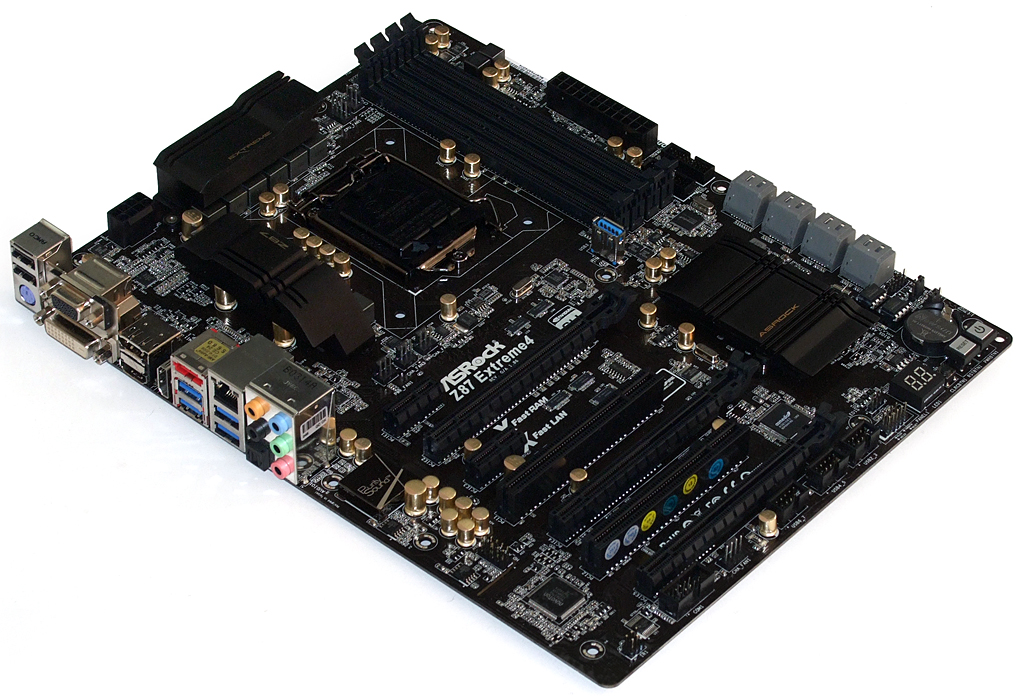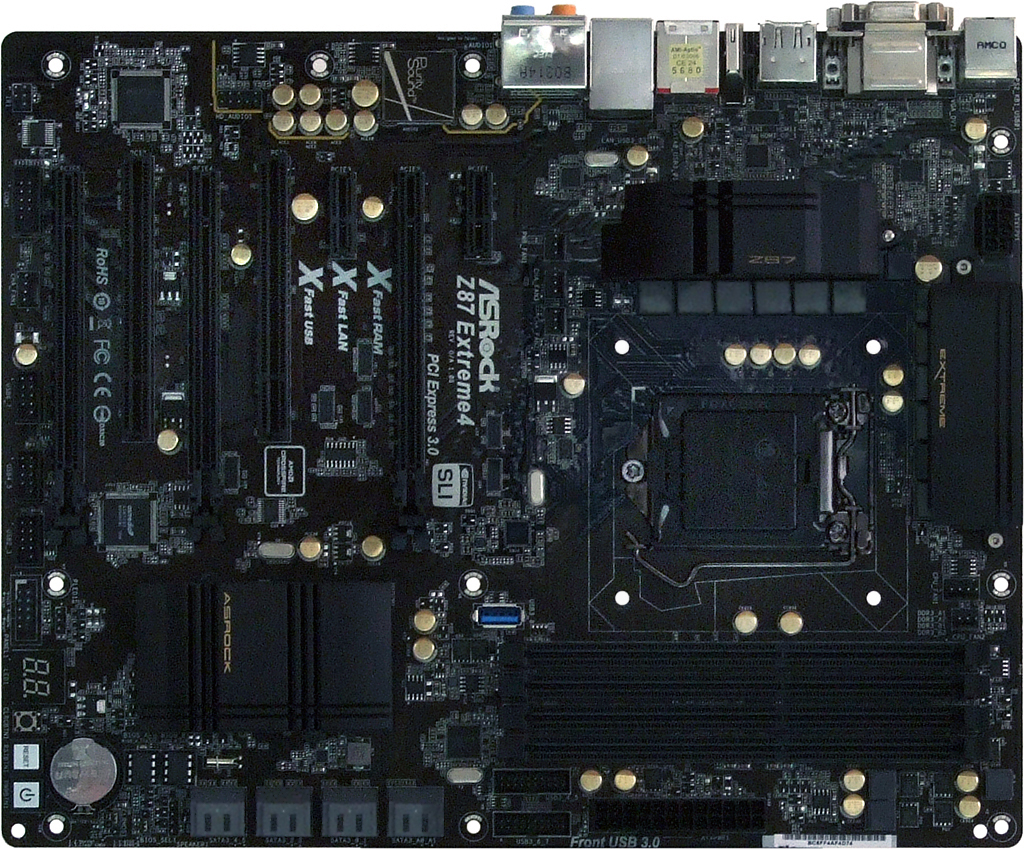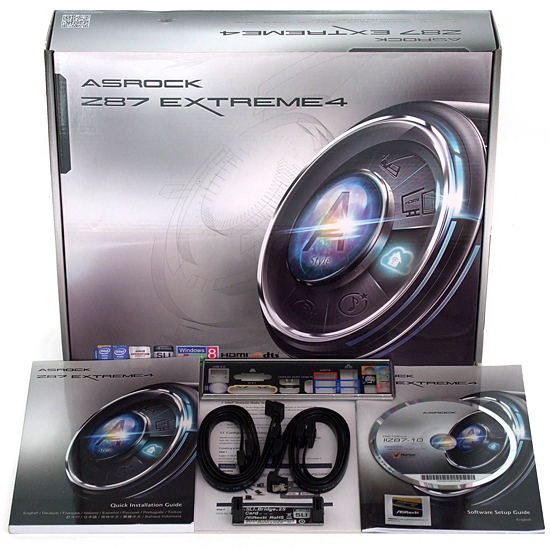Fast And Cheap? Five Sub-$160 Z87 Motherboards For Enthusiasts
Intel’s Haswell architecture has mainstream leanings. And yet some of the motherboards out there are really high-end. Today we're looking at five platforms under the $160 mark that hopefully put some value back into being an enthusiast.
ASRock Z87 Extreme4
Why you can trust Tom's Hardware
ASRock hopes to demolish its competition in the enthusiast-value segment by providing a full set of features for less than $160 (sometimes even less than $150, depending on the deal of the day; ASRock's prices tend to move a lot more than we're used to). That full set includes three-way CrossFire using PCI Express 3.0 slots, four front-panel USB 3.0 ports, an extra eSATA 6Gb/s controller, HDMI monitor pass-through for external devices like game consoles, Intel's own network controller hardware, and DTS Connect-enabled ALC1150 audio.
The combination of five analog outputs and DTS Connect over optical S/PDIF gives users a wide range of options to connect multi-channel speaker systems, though the four nearby USB 3.0 ports seem sparse on a board that hosts an extra four-port hub.
Those missing USB 3.0 ports are instead found on a second front-panel header, yielding a total of four USB 3.0 and six USB 2.0 front-panel connections. The USB 3.0 hub consumes one of the Z87 Express PCH's native ports, so ASRock exposes the left-over interface as an external connector mounted internally, where it can be used to attach USB-based Wi-Fi, flash, or Bluetooth.
Three PCIe x16 slots connect the CPU’s 16 PCIe 3.0 lanes in x16/x0/x0, x8/x8/x0, or x8/x4/x4 modes. We’re typically not fans of four-lane connections for graphics, but the use of PCI Express 3.0 should alleviate any bottleneck that would have earned our ire in the past. Unfortunately, three-way SLI is officially unsupported, though Nvidia fans can still use the three slots for two-way SLI plus a third card.
ASRock moves the front-panel audio connector three slots up from the traditional bottom-rear corner to shorten the distance to its audio solution, which itself is moved closer to the I/O panel. This design, along with a TI NE5532 600 Ω-compatible headphone amplifier and enhanced EMI shielding, make up its Purity Sound solution.
The relocated front-panel connector benefits builders using cases with audio cables that can't quite reach the bottom-rear corner. On the other hand, if you prefer wrapping that cable around the bottom of your motherboard tray, you might now have to go over the board's top, which looks a little messier. These board vendors can't please everyone, it seems.
Less controversial are the power, reset, and CLR_CMOS buttons next to a two-digit diagnostics display. While most mainstream folks rarely need those features, they often come in handy when we're testing hardware outside the confines of a case. ASRock even sockets its two firmware ICs in case you somehow manage to corrupt them both.
The Z87 Extreme4 supports up to eight SATA drives, but includes only four cables (that’s a total of eight drives, since the eSATA connector is shared with one of the added internal ports).
Current page: ASRock Z87 Extreme4
Prev Page Affordable Z87 Express Motherboards: Not Quite "Back To Basics" Next Page Z87 Extreme4 FirmwareGet Tom's Hardware's best news and in-depth reviews, straight to your inbox.
-
InvalidError The sad things about "exposing enthusiast features" on z87:Reply
1- the x8x4x4 PCIe controller is a CPU feature in all i5 and i7. All the z*7 chipset does is unlock the CPU feature
2- same goes for multipliers on K-chips: CPU feature locked out by non-z*7 chipsets
3- SATA-6G ports do not really cost Intel any thing extra to put on-chip (little more than a PLL tweak to lock on faster signals), which makes it somewhat of a shame they aren't fully standard
4- USB3 ports do not cost Intel all that much extra either - maybe an extra square millimeter on silicon to upgrade all remaining USB2 ports to USB3
5- the DMI bus can only manage ~20Gbps so it will bottleneck if you attempt to use even 1/5th the total the connectivity available on z87
More connectivity, yes. But DMI lacks the muscle to actually stress that extra IO. As such, it is little more than a glorified SATA port replicator and USB hub.
I almost exclusively use Intel CPUs but it still annoys me how Intel charges extra for trivial things or unlock stuff they arbitrarily locked out just because they can. -
Crashman Reply
It still saves motherboard makers a lot of money when they don't need to add all those controllers. And it frees up some of those x1 slots. Remember that most users don't use "everything at once" to fill up the DMI, so having the x1 slots available rather than consumed by onboard devices adds flexibility to a build.11349374 said:The sad things about "exposing enthusiast features" on z87:
1- the x8x4x4 PCIe controller is a CPU feature in all i5 and i7. All the z*7 chipset does is unlock the CPU feature
2- same goes for multipliers on K-chips: CPU feature locked out by non-z*7 chipsets
3- SATA-6G ports do not really cost Intel any thing extra to put on-chip (little more than a PLL tweak to lock on faster signals), which makes it somewhat of a shame they aren't fully standard
4- USB3 ports do not cost Intel all that much extra either - maybe an extra square millimeter on silicon to upgrade all remaining USB2 ports to USB3
5- the DMI bus can only manage ~20Gbps so it will bottleneck if you attempt to use even 1/5th the total the connectivity available on z87
More connectivity, yes. But DMI lacks the muscle to actually stress that extra IO. As such, it is little more than a glorified SATA port replicator and USB hub.
I almost exclusively use Intel CPUs but it still annoys me how Intel charges extra for trivial things or unlock stuff they arbitrarily locked out just because they can.
In other words, they might be charging for stuff that should be free or should have been included all the way back in the Z68, but past omission doesn't negate current usefullness.
-
DookieDraws I am planning a new Haswell build, soon, and I really appreciate the the effort put into this review. Very helpful!Reply
The market is flooded with tons of these Z87 motherboards and it can be very overwhelming researching them. So, hopefully we'll see a few more Z87 reviews from you guys, soon.
Would also like to see some powerful i7 builds built around more energy efficient components. That would be very interesting. Hint. :) -
Novuake Yeah, I would not be caught dead with a Biostar board. Booo... Interesting that the G45 did not overclock to well, they are usually not the best OCers due to low cost VRMs, thought this would change with Haswell. Hmmm...Reply -
axehead15 I really think that ASRock has taken a lot of steps to put the naysayers to rest. The amount of features that is on these boards for the cost is incredible.Reply
Rather surprised that Biostar had such a good board. Maybe it's time to start considering those boards for future builds. -
JPNpower Can anybody tell me the true difference between the Asus Z87-A and Z-87 plus, without all the marketing hogwash? I'm confused what the difference is. (woth say $15 extra for the plus?)Reply -
vertexx Trying to pick a winner based strictly on the numbers - tough when the measured numbers have been commoditized to the extent they have. Funny to give in on ASRock based on a temporary price break. I think the feature-set vs. value helps ASRock stand on it's own. I really think there is a good target audience for each of these boards. Pulling that out would be a great analysis.Reply
It is great to see a round-up of the mainstream boards, though, so thanks! -
InvalidError Reply
Most users don't have enough such devices to fill every port in the first place (how many people need more than two upper-tier SSDs?) but those who might actually "need" and use 6xSATA-6G would be people wanting to do things like RAID0/1/5 with 3-6x SSDs. At 6x SSDs, we would be looking at ~25Gbps peak not counting GbE, USB3 or PCIe devices on the 8x 2.0 lanes.11349464 said:It still saves motherboard makers a lot of money when they don't need to add all those controllers. And it frees up some of those x1 slots. Remember that most users don't use "everything at once" to fill up the DMI, so having the x1 slots available rather than consumed by onboard devices adds flexibility to a build.
Still does not change the fact that the only reason why Intel gets away with charging $10-15 extra for less than $1 worth of features while the DMI bus lacks the bandwidth to properly support them for people who may actually intend to use them is because they have a practical monopoly which allows them to arbitrarily fragment the market so they can artificially inflate prices.
The main reason most people go with z?7 is the overclock unlock for K-chips. That itself is the biggest joke since it is a completely artificial limitation Intel engineered into their products to enforce co-upselling. As shown with the h87 slip-up, the h87 is perfectly capable of managing multipliers on Haswell K-chips when the K-chip lacks the microcode to enforce the z87 unlock "requirement."
I don't bother with overclocking so this does not affect me... but it still annoys me on the basis of principles and general dislike for hair-splitting for profit.



